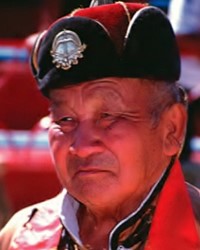Kalmyk-Oirat, Western Mongol in Russia

Photo Source:
Copyrighted © 2026
Anonymous All rights reserved. Used with permission |
Send Joshua Project a map of this people group.
|
| People Name: | Kalmyk-Oirat, Western Mongol |
| Country: | Russia |
| 10/40 Window: | No |
| Population: | 179,000 |
| World Population: | 521,600 |
| Primary Language: | Kalmyk-Oirat |
| Primary Religion: | Buddhism |
| Christian Adherents: | 0.16 % |
| Evangelicals: | 0.16 % |
| Scripture: | New Testament |
| Ministry Resources: | Yes |
| Jesus Film: | Yes |
| Audio Recordings: | Yes |
| People Cluster: | Mongolian |
| Affinity Bloc: | East Asian Peoples |
| Progress Level: |
|
Introduction / History
The Kalmyks of Russia are Mongolian in origin. In the 16th century, the Kalmyks, or Oirat, left their homeland, now known as areas of northwest China, to avoid political and economic pressures. They had hopes of settling in the rich pastures of the northern Causasus Mountains.
In 1771, the majority of the Oirats decided to move back to their homeland in order to escape the Russian dictatorship, but only a few survived the long journey. Those who stayed behind in Russia became known as the Kalmyks, which means "to remain." As Kalmyks looked for their identity, they discovered it in Buddhism.
In 1943, Stalin had the Kalmyk descendants deported to Siberia for allegedly uniting with occupying Nazi troops. About half did not survive the Siberian cold; others were so dispersed that the Kalmyk language and culture suffered irreversible decline. In 1957, after Stalin's death, they were allowed to return home. Modern day Kalmykia is located north of the Caspian Sea and west of the Volga River. Animosity still remains between Russians and Kalmyks.
After their return from Siberia, many Kalmyks were forced to conform to the Soviet lifestyle, living in traditional gray, five story apartment complexes of the 1950s and working in industrial plants. After Perestroika, or the collapse of the Soviet regime, the economy disintegrated and factories closed, leaving many unemployed and causing widespread hardship.
What Are Their Lives Like?
Kalmykia is composed of steppes (treeless plains), semi-desert and desert. It does not have good soil for crops. In rural areas, there are herdsmen who raise cattle, sheep, goats, and a few camels. They are known for their love of fine horses and horse racing. Those who live in the narrow neck of land with access to the Volga River are fishermen. Many have a small garden plot in the yard, growing melons, corn, and potatoes for their families. Some are employed in the trades, earning barely sustainable wages. Others continue to live as nomads, their lives characterized by seasonal migrations. Their dwellings are portable tents called yurts.
Kalmyk-Oirat people traditionally lived in extended family units with a mother and father, married sons and their families, and unmarried sons and daughters. Today there is a growing tendency toward nuclear families. Couples usually marry in their early to mid-twenties. Kalmykian law still allows polygamy. Sadly, divorce is becoming more common, and legal abortion is the principal means of birth control.
The traditional Kalmyk-Oirat dress includes velvet hats, loose fitted coats, and heavily padded long pants. Men often shave their heads, except for one small area in the back that is reserved for a ponytail.
Oral history in an important part of Kalmyk-Oirat culture. It is traditionally recited by a poet and accompanied by a two stringed lute called a dombr. Favorite past-times include storytelling and singing.
Their diet is largely one of meat and milk. At social gatherings, Kalmyks enjoy drinking kumiss (fermented mare's milk) or Kalmyk tea made of tea leaves, milk, butter, salt, nuts and sometimes even meat.
What Are Their Beliefs?
In the late 1500s, Kalmyk-Oirats adopted Tibetan Buddhism. Many were later forced to convert to Russian Orthodoxy. Their form of Buddhism is a mixture of ethnic beliefs and Shamanism (belief in unseen gods, demons, and spirits). The people continue to depend on shamans, or medicine men, despite laws forbidding their practices to cure the sick by magic and communication with the gods. The obo, a heap of stones thought to be inhabited by local spirits, often serves as a site for performing various rituals. Occultism is occurring as Kalmyk-Oirats have the custom of going to a Buddhist temple and inviting the gods to live inside them. Many are possessed by demons. Some are now being persuaded to join the Muslim religion.
In the 1990s the first positive wave to accept Christ began, and ambitious Christian pastors in Kalmykia have plans to establish churches in all seven regions.
What Are Their Needs?
Medical facilities are inadequate. Limited water supply, poor hygiene, deficient diet and alcoholism are common problems. Kalmyk-Oirats have a high infant mortality rate, low life expectancy, and persistence of diseases like tuberculosis.
Prayer Points
Ask the Holy Spirit to soften the hearts of the Kalmyk-Oirat people so that they will be receptive to the love of Jesus.
Ask the Lord to call dedicated workers to go to Russia and share Christ with the Kalmyk-Oirat.
Pray that God will send Christian medical teams to work among these precious people.
Pray that God will raise up teams of intercessors who will faithfully stand in the gap for the Kalmyks.
Ask the Lord to raise up strong local churches among Kalmyk-Oirats.